Video of the Week:
Protecting Fruit Trees from Deer
Flowers:
Time to Plant Spring Flowering Bulbs
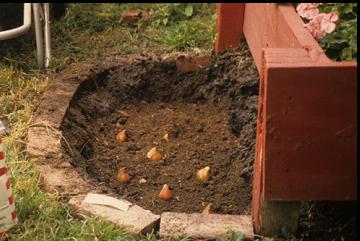
Choose a planting site that has full sun to partial shade. The ideal soil would be a sandy loam, but even poor soils can be used if organic material such as peat moss, compost, or aged bark is mixed in. For example, a heavy clay can be amended by mixing in one-third to one-half organic material. Soil pH should be between 6.0 and 7.0.
Bulbs need good aeration as well as good drainage for proper development. It is best if the bulbs are given 12 inches of prepared soil. If one-third organic material were added, this would require mixing 4 inches of organic material with 8 inches of soil. Incorporate about 3 pounds of a complete fertilizer such as a 5-10-5 per 100 square feet during preparation or fertilize according to soil test.
Planting depths vary depending on the size of the bulbs. For example, tulips and hyacinths are set about 6 inches deep, and daffodils are put 6 to 8 inches deep. Smaller bulbs are planted shallower. As a rule of thumb, bulbs are planted two to three times as deep as their width. Planting depth is the distance from the bottom of the bulb to the top of the soil. Large bulbs are normally spaced 4 to 6 inches apart, and small bulbs about 1 to 2 inches. Planting in clumps or irregular masses produces a better display than planting singly.
After placing the bulbs at the proper depth, replace half the soil and add water. This will settle the soil around the bulbs and provide good bulb/soil contact. Add the remaining soil and water again. Although there will be no top growth in the fall, the roots are developing, so soil needs to be kept moist but not wet. Mulch can be added after the soil has frozen to prevent small bulbs from being heaved out of the soil by alternate freezing and thawing. (Ward Upham)
Bringing Amaryllis Back into Bloom
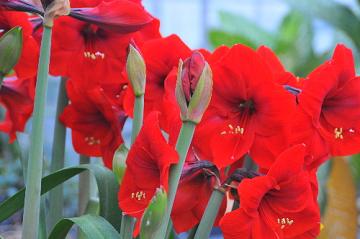
Amaryllis needs temperatures between 50 and 60 degrees during the period before flowering. Higher temperatures can weaken leaves. The flower bud may start to appear right away or the plant may remain dormant for a period of time, but eventually all mature bulbs do bloom if they have been given proper care during the growing season. Keep the plant in a cool location and out of direct sunlight when the flower buds begin to show color so that the flowers last longer. Amaryllis can remain in bloom for about a month. (Ward Upham)
Vegetables:
Rotation of Vegetable Crops
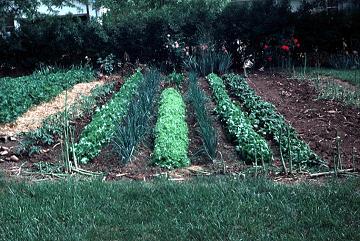
As mentioned earlier, it is also a good idea to avoid planting closely related crops in the same area as diseases may be shared among them. For example, tomatoes, potatoes, peppers and eggplant are closely related. Also, broccoli, cauliflower, cabbage and brussels sprouts share many characteristics in common. Therefore, do not plant cabbage where broccoli was the previous year or tomatoes where the peppers were.
So, why is this important to bring this up in the fall? Now is the time to make a sketch of your garden so that the layout is not forgotten when it is time to plant next year. (Ward Upham)
Pests:
Be on the Lookout for Goldenrod Soldier Beetles
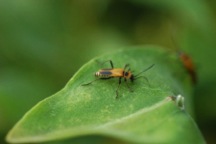
Adults are about 1/2 inch (12 mm) in length, elongated, and orange in color with two dark bands on the base of the forewings (elytra) and thorax (middle section). They are typically present from August through September. Adult soldier beetles feed on the pollen and nectar of flowers, but they are also predators and may consume small insects such as aphids and caterpillars. Flowers are a great place for the male and female soldier beetle adults to meet, get acquainted, and mate (there is no wasting time here). Soldier beetle adults do not cause any plant damage. Sometimes adults may enter homes; however, they are rarely a concern. The best way to deal with adults in the home is to sweep, handpick, or vacuum.
Adult females lay clusters of eggs in the soil. Larvae are dark-colored, slender, and covered with small dense hairs or bristles which gives the larvae a velvety appearance. Larvae reside in the soil where they feed on grasshopper eggs; however, they may emerge from the soil to feed on soft-bodied insects and small caterpillars. (Raymond Cloyd)
Twig Girdler
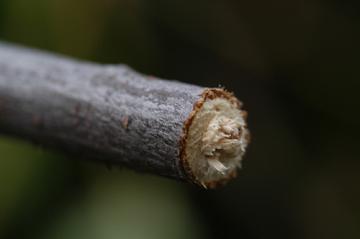
The girdling process is not a complete shearing of branches. Rather, the smooth cut stops, but an intact central core remains, thus preventing the branch from dropping. However, because girdling severs vascular elements, the portion of the branch beyond the girdle dies and dries out. This results in the central core becoming brittle. It is at this point the weight of the branch (with or without the aid of the wind) overcomes the ability of the core to support the branch. The core snaps and the branch falls to the ground.
Twig girdlers have a wide host range including hickory, pecan, dogwood, honeylocust, oak, maple and hackberry. While hackberry is listed as “high” on the list of hosts, in Kansas, most reports of littered lawns occur beneath elms. This preference for elm over hackberry was exemplified in an observation of side-by-side girdled elms and untouched hackberry trees.
For homeowners, twig girdlers are more of a nuisance in causing the aforementioned branch litter. The recommendation is to gather up and dispose of branches. This will eliminate those beetles which emerge the following year. However, this does not mean that twig girdlers won’t appear the following year. Look up and you may see many more dead branches still attached or caught up in tree canopies. (Bob Bauernfeind)
Miscellaneous:
Why do Houseplants Lose Leaves after Being Brought Inside?
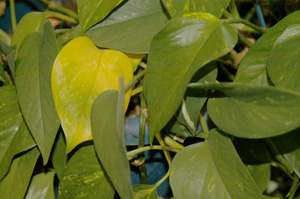
Research done in Florida in the late 1970s revealed that tropical plants grown under high light conditions produce "sun leaves" while those grown under low light conditions have "shade leaves." These leaf types differ structurally in that sun leaves have less chlorophyll (the substance that plants use to convert sunlight to energy) and the chlorophyll that is present is located deeper inside the leaf. Sun leaves also tend to be thick, small and numerous while shade leaves are more thin, larger, and fewer in number.
When plants are moved from one light condition to another they need time to adjust. This process is known as acclimatization. If they are forced to acclimatize too quickly, they will drop their sun leaves and produce a new set of shade leaves. If the acclimatization process is slower and less drastic, the plant can convert their sun leaves to the shade leaves that do better under low light. If going from shade to sun, this process is reversed. Some houseplants are acclimatized before they are sold but many are not.
So how do we help our new houseplants or those moved inside acclimatize to their new home environment? Houseplants should start out in an area of the home that receives plenty of light and then gradually moved to their permanent, darker location. This process should take 4 to 8 weeks depending on the degree of difference in light levels between the initial and final location of the plant. Remember, plants need to be acclimatized whether they are moved from a sunny location to one that receives less light or from shade to sun. Understanding plant processes allows us to anticipate potential problems. Acclimatization gives our houseplants a greater chance of retaining leaves and avoiding the stress of completely replacing them. (Ward Upham)
Contributors: Bob Bauernfeind, Entomologist; Raymond Cloyd, Entomologist; Ward Upham, Extension Associate
 RSS Feed
RSS Feed
